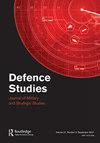Engaging with emerged and emerging domains: cyber, space, and technology in the 2022 NATO strategic concept
Q1 Arts and Humanities
引用次数: 3
Abstract
ABSTRACT Cyber, space, and emerging technologies have transformed the strategic environment. Since the last publication of the NATO Strategic Concept, the Alliance has responded to this changing environment by addressing emerged and emerging threats at differential rates of operational and policy planning. Now, NATO must seek to holistically integrate these domains into the forthcoming strategic concept to increase the resilience and effectiveness of the Alliance. An adaptable and resilient Alliance that responds to the challenge of cyber, space, and emerging technologies will be best realized through three primary avenues. First, reaching preemptive consensus on actions short-of-force and consensus on space and cyber actions that trigger Article 5 will enhance collective defense and crisis management. Second, communication of capabilities and resolve will promote deterrence and enhance cooperative security among member states. Finally, cooperation with industry partners and among Allies to maintain a cutting technological edge is essential for NATO’s collective defense against emerging threats and enhances cooperative security through a common strategic culture of innovation. It is essential that NATO prevents cyber, space, and emerging technologies from being understood and actioned in isolation, and instead thoughtfully integrates technologies into the Alliances’ key tasks.参与新兴领域:2022年北约战略概念中的网络、空间和技术
摘要网络、太空和新兴技术已经改变了战略环境。自上一次《北约战略构想》发表以来,北约对这一不断变化的环境作出了回应,以不同的行动和政策规划速度应对新出现的威胁。现在,北约必须寻求将这些领域全面纳入即将到来的战略概念,以提高联盟的韧性和有效性。应对网络、太空和新兴技术挑战的适应性和弹性联盟将通过三个主要途径实现。首先,就缺乏武力的行动达成先发制人的共识,并就引发第5条的太空和网络行动达成共识,将加强集体防御和危机管理。第二,沟通能力和决心将促进威慑,加强成员国之间的合作安全。最后,与行业合作伙伴和盟国之间的合作以保持领先的技术优势,对于北约集体防御新出现的威胁和通过共同的创新战略文化加强合作安全至关重要。至关重要的是,北约应防止网络、太空和新兴技术被孤立地理解和采取行动,而是深思熟虑地将技术整合到联盟的关键任务中。
本文章由计算机程序翻译,如有差异,请以英文原文为准。
求助全文
约1分钟内获得全文
求助全文

 求助内容:
求助内容: 应助结果提醒方式:
应助结果提醒方式:


